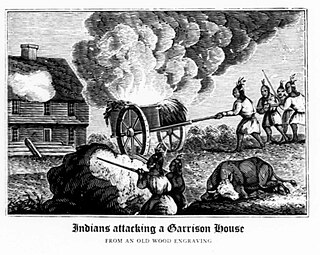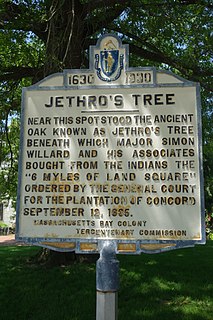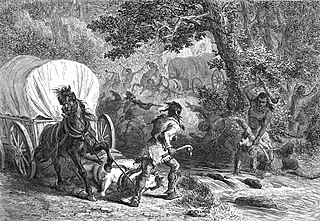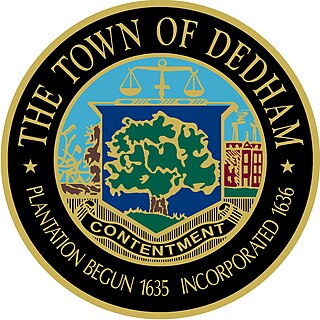Related Research Articles

Metacomet, also known as Pometacom, Metacom, and by his adopted English name King Philip, was sachem to the Wampanoag people and the second son of the sachem Massasoit. Metacom became sachem in 1662 when his brother Wamsutta died shortly after the death of their father. Wamsutta's widow Weetamoo, sachem of the Pocasset, was Metacom's ally and friend for the rest of his life. Metacom married Weetamoo's younger sister Wootonekanuske. It is unclear how many children they had or what happened to them. Wootonekanuske and one of their sons were sold to slavery in the West Indies following the defeat of the Native Americans in what became known as King Philip's War.

King Philip's War was an armed conflict in 1675–1678 between indigenous inhabitants of New England and New England colonists and their indigenous allies. The war is named for Metacom, the Wampanoag chief who adopted the name Philip because of the friendly relations between his father Massasoit and the Mayflower Pilgrims. The war continued in the most northern reaches of New England until the signing of the Treaty of Casco Bay on April 12, 1678.

John Alderman, also known as Isaac and Antoquan, was a Wampanoag praying Indian who shot and killed the rebellious Native American leader Metacomet in 1676, during King Philip's War, while taking part in a punitive expedition led by Captain Benjamin Church. Alderman was a subsachem in the Westport/Dartmouth area of what is now Bristol County, Massachusetts. He was called Alderman because he was considered a close associate and counselor for King Philip. When Philip summarily murdered Alderman's brother in front of him because of his dissension, Alderman changed sides and joined Benjamin Church, an English colonist who had settled in nearby Little Compton.
Praying Indian is a 17th-century term referring to Native Americans of New England, New York, Ontario, and Quebec who converted to Christianity either voluntarily or involuntarily. Many groups are referred to by the term, but it is more commonly used for tribes that were organized into villages. The villages were known as praying towns and were established by missionaries such as the Puritan leader John Eliot and Jesuit missionaries who established the St. Regis and Kahnawake and the missions among the Huron in western Ontario.

Samuel Willard was an American Puritan clergyman. He was born in Concord, Massachusetts, graduated from Harvard College in 1659, and was minister at Groton from 1663 to 1676, before being driven out by the Indians during King Philip's War. Willard was pastor of the Third Church, Boston, from 1678 until his death. He opposed the Salem witch trials and was acting president of Harvard University from 1701. He published many sermons; the folio volume, A Compleat Body of Divinity, was published posthumously in 1726.

The Great Swamp Fight or the Great Swamp Massacre was a crucial battle fought during King Philip's War between the colonial militia of New England and the Narragansett people in December 1675. It was fought near the villages of Kingston and West Kingston in the Colony of Rhode Island and Providence Plantations. The combined force of the New England militia included 150 Pequots, and they inflicted a huge number of Narragansett casualties, including many hundred women and children. The battle has been described as "one of the most brutal and lopsided military encounters in all of New England's history." Since the 1930s, Narragansett and Wampanoag people commemorate the battle annually in a ceremony initiated by Narragansett-Wampanoag scholar Princess Red Wing.
Thomas Minor was a founder of New London and Stonington, Connecticut, United States, and an early colonial New England diarist.

Simon Willard (1605–1676) was an early Massachusetts fur trader, colonial militia leader, legislator, and judge.

Captives in American Indian Wars could expected to be treated differently depending on the identity of their captors and the conflict they were involved in. During the American Indian Wars, indigenous peoples and European colonists alike frequently became captives of hostile parties. Depending on the specific instances in which they were captured, they could either be held as prisoners of war, abducted as a means of hostage diplomacy, used as countervalue targets, enslaved, or apprehended for purposes of criminal justice.
Matoonas was a sachem of the Nipmuc Indians in the middle of 17th century. He played a significant role in the Native American uprising known as King Philip's War.
Thomas Wheeler was a colonial soldier of the Massachusetts Bay Colony. In 1675 he took part in King Philip's War; later he wrote a narrative based on his experiences.

The Battle of Bloody Brook was fought on September 18, 1675 OS between English colonial militia from the Massachusetts Bay Colony and a band of Indians led by the Nipmuc sachem Muttawmp, during King Philip's War. The Indians ambushed colonists escorting a train of wagons carrying the harvest from Deerfield to Hadley, and killed at least 40 militia men and 17 teamsters out of a company that included 79 militia.

The Battle of Turner's Falls or Battle of Great Falls; also known as the Peskeompscut massacre or the "Wissantinnewag massacre", was fought on May 19, 1676, during King Philip's War, in present-day Gill, Massachusetts, near a falls on the Connecticut River. The site is across the river from the village of Turners Falls. This was one of the most important conflicts of King Philip's War, as it marked a turning point in the conflict that would eventually lead to the war's end.

Sam Hide is a historic or apocryphal character in the folklore of New England, used in the folk saying "to lie like Sam Hide". There is no record of the death of a Sam Hide in the records of Dedham, Massachusetts though he is said to have died in 1732, however Sam Hide is noted at age 105 at Dedham as being a sachem, chief or sagamore who first and last were, to a greater or less degree, land-holders, and leaders of the multifarious tribes of New England.
Richard Olmsted was a founding settler of both Hartford and Norwalk, Connecticut. He served in the General Court of the Connecticut Colony in the sessions of May 1653, October 1654, May 1658, October 1660, May 1662, May and October 1663, May and October 1664, October 1665, May and October 1666, May 1667, May and October 1668, May 1669, May 1671, and May 1679.

George Madison Bodge was an American author and historian best known for his study of King Philip's War. He also wrote and edited numerous articles and books focusing on the Unitarian Church and genealogy.
The First Abenaki War was fought along the New England/Acadia border primarily in present-day Maine. Richard Waldron and Charles Frost led the forces in the northern region, while Jean-Vincent d'Abbadie de Saint-Castin worked with the tribes that would make up the Wabanaki Confederacy. The natives engaged in annual campaigns against the English settlements in 1675, 1676 and 1677. Waldron sent forces so far north that he attacked the Mi'kmaq in Acadia.

Samuel Guild represented Dedham, Massachusetts in the Great and General Court. He also served 20 terms as selectman, beginning in 1693.
Pumham was one of Metacomet's chief advisors during King Phillip's War. He was sachem of Shawomet. He was described as "one of the stoutest and most valiant sachems that belonged to the Narragansett." He was friends with English settlers, but aligned himself with Metacomet when war broke out.
Samuel Man was an early teacher in Dedham, Massachusetts and minister in Wrentham, Massachusetts.
References
- ↑ Breen, Louise A. (October 21, 2019). Daniel Gookin, the Praying Indians, and King Philip's War: A Short History in Documents. Routledge. pp. 23, 109–111, 114, 174, 180–182.
- 1 2 3 4 5 6 7 8 9 Gay, Frederick Lewis (1892). "Extracts from the Sewall Diary". The Dedham Historical Register. Dedham Historical Society: 164–165.
- 1 2 3 4 5 6 7 Bodge, George Madison (1896). Soldiers in King Philip's War: Being a Critical Account of that War, with a Concise History of the Indian Wars of New England from 1620-1677, Official Lists of the Soldiers of Massachusetts Colony Serving in Philip's War, and Sketches of the Principal Officers, Copies of Ancient Documents and Records Relating to the War, Also Lists of the Narragansett Grantees of the United Colonies, Massachusetts, Plymouth and Connecticut. author. pp. 289–290. Retrieved April 19, 2021.
- 1 2 3 4 5 6 7 Ellis & Morris 1906, p. 212.
- 1 2 3 Frothingham, Richard (1845). The History of Charlestown, Massachusetts. Charlestown (Boston, Mass.): C.C. Little and J. Brown. Retrieved August 27, 2021.
- ↑ Cowley, Charles (1868). History OF Lowell (second ed.). Lee and Shepard. p. 20-21. ISBN 9783849676704 . Retrieved August 27, 2021.
- ↑ Bedini, Silvio A. (2003). "The History Corner: Joshua Fisher (1621-1672) Colonial Inn-keeper and Surveyor, Part 1". Professional Surveyor Magazine (September). Retrieved April 17, 2021.
- 1 2 3 4 5 Hanson 1976, p. 96.
- ↑ Puglisi, Michael J. (1987). "The legacies of King Philip's War in the Massachusetts Bay Colony". The College of William and Mary Dissertations, Theses, and Masters Projects: 54. doi:10.21220/s2-f5eh-p644. Paper 1539623769. Retrieved August 27, 2021.
{{cite journal}}: Cite journal requires|journal=(help)